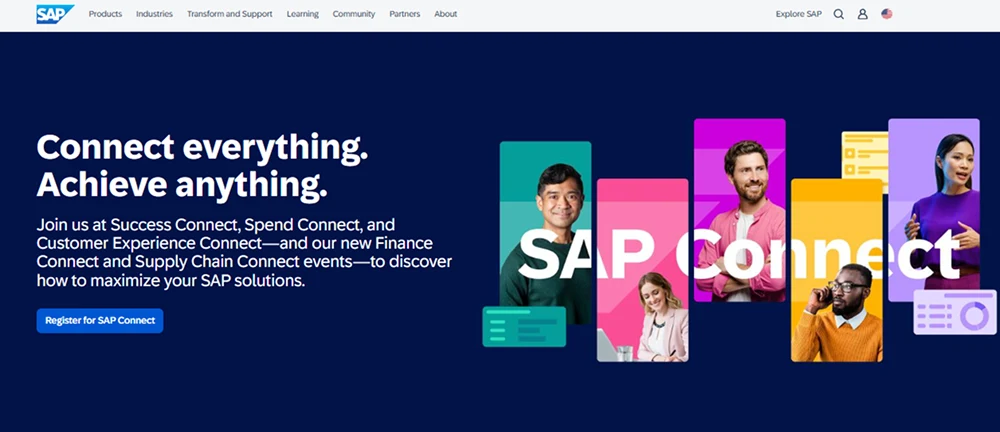SAP Business One/SAP ByDesign Overview & 2025 Industry Position
SAP Business One and SAP Business ByDesign are modular Enterprise Resource Planning (ERP) solutions designed for small to medium-sized enterprises (SMEs) and mid-market businesses ready for scalable growth. In 2025, they remain strategic tools for businesses navigating increasingly regulated, AI-assisted, and cloud-dependent markets.
Both platforms are part of SAP’s broader cloud strategy. SAP Business One is ideal for smaller firms seeking on-premise or hosted flexibility with industry-specific extensions, while SAP Business ByDesign offers a full SaaS suite with built-in analytics and global capabilities. Together, they cover a broad SMB use case spectrum, offering tailored ERP pathways depending on operational complexity, industry, and internal IT maturity.
From Launch to 2025: SAP Business One/SAP ByDesign’s Journey
SAP launched SAP Business One in 2002 after acquiring TopManage; it quickly became a leading ERP option for small businesses seeking core functionality like financials, CRM, and inventory. SAP Business ByDesign debuted in 2007 as a mid-market SaaS ERP, ideal for subsidiaries or fast-growing firms needing global, cloud-native usability.
- 2002: SAP Business One acquisition marks SMB entry.
- 2007: SAP Business ByDesign launches as first full-SaaS ERP.
- 2011: HANA support enhances analytics for Business One.
- 2015: ByDesign revamped UI and mobile-first components.
- 2020: Integration focus (SAP Cloud Platform and APIs).
- 2023: Industry-specific templates added; AI roadmap introduced.
2025 Strategy Thesis: SAP Business One and SAP Business ByDesign now serve as modular ERP frameworks that empower SMBs to digitalize gradually while embracing AI and automation workflows.

SAP Business One/SAP ByDesign Key Features
Both platforms provide essential ERP modules, but their deployment models and extensibility define their differences:
- Core Modules: Financial management, CRM, project management, procurement, inventory, and production planning.
- Platform Model: Business One supports hybrid / on-prem deployments; ByDesign is fully SaaS with built-in analytics and compliance layers.
- Industry Templates: Pre-configured for manufacturing, wholesale, life sciences, and professional services.
- AI & Automation (2025): Predictive analytics, auto-ordering, and machine learning layered into workflows.
- Mobile & Web Access: Intuitive Fiori-based interface with mobile functionality for field teams.
Workflow & UX Design
SAP’s consistent design system ensures that users across both Business One and ByDesign solutions experience low learning curves and task efficiency:
- Unified Look: Fiori-inspired interface with consistent iconography and layout across modules.
- Smart Worklists: Predefined views for quicker decision making.
- Role-Based Access: Custom dashboards based on job title and department.
- Mobile UX: Smooth app transition with notification integrations via SAP Mobile App Suite.
Pro Tip: Use the SAP Fiori App Library to preview UX behaviors before deploying modules, which reduces adoption friction.
SAP Business One/SAP ByDesign Pricing Analysis & Value Metrics
| Plan | Deployment | Price (July 2025) | Inclusions |
|---|---|---|---|
| Business One Starter | Cloud/On-Prem | $110/user/month | Core finance, sales, inventory |
| Business One Pro | Cloud/On-Prem | $149/user/month | Full modules + HANA + API access |
| Business ByDesign Base | Cloud SaaS | $175/user/month | Complete ERP package |
| ByDesign Advanced | Cloud SaaS | $210/user/month | AI workflows, compliance reporting |
Value Score (2025): 8.5/10 — Higher than average ERP cost, but value remains high if deployed for regulated or growth-ready SMEs.
Competitive Landscape
| Platform | Best For | Key Advantage | Cost Level |
|---|---|---|---|
| SAP Business One/SAP ByDesign | SMBs scaling with compliance needs | Modular ERP + global reach | $$$ |
| NetSuite ERP | Venture-backed mid-market firms | Integrated CRM & e-commerce | $$$$ |
| Odoo | Entry-level digitalization | Open source flexibility | $ |
| Zoho One | SaaS-only small teams | Bundle value | $ |
Common Use Cases
- Manufacturers: Production planning, batch control, and vendor integration.
- Life Sciences: Regulatory and quality compliance tracking.
- Professional Services: Timesheet, project tracking, and unified invoicing.
- Retail/Wholesale: Inventory flows, multichannel sync, and POS compatibility.
- Subsidiaries of Global Brands: Lightweight options for aligning with SAP S/4HANA HQ systems.
Integrations & Ecosystem
SAP Business One/SAP ByDesign integrations bridge third-party apps and native SAP ecosystems:
- Payment Gateways: Stripe, PayPal, Authorize.net
- CRM Tools: Salesforce, HubSpot
- eCommerce: Magento, Shopify, BigCommerce
- Payroll: ADP, Gusto, SAP SuccessFactors
- Analytics: SAP Analytics Cloud, Power BI
Pros & Cons
- Pros:
- Comprehensive ERP suite tailored for SMBs
- Scalable to mid-size enterprise use cases
- Global-ready SaaS in Business ByDesign
- Extensive integration options
- Ahead on AI-led automation workflows (2025)
- Cons:
- Higher price point than many competitors
- Customization limit for non-tech users
- Learning curve for complex modules
Final Thoughts
SAP Business One/SAP ByDesign offer a thought-out continuum for businesses poised for digital ERP adoption. If you’re scaling fast, facing regulatory challenges, or need unified dashboards across multiple functions, either platform can bring architectural clarity to your operations.
You’ll want to weigh cost against depth—especially if you’re deciding between ByDesign’s full SaaS scope or Business One’s flexibility for on-premise controls. In either case, you’re aligning with the clarity and power of the SAP ecosystem—built to last through 2025 and beyond.
SAP Business One/SAP ByDesign FAQ
Business One is best for small firms needing flexibility and local control (on-prem or hosted), while ByDesign is cloud-native and built for growing midsize companies or subsidiaries.
Yes, SAP continues full platform support for SAP Business ByDesign in 2025, including new industry templates and generative AI integrations.
Implementation time varies—from 8 to 16 weeks for Business One, and 16–24 weeks for ByDesign, depending on system complexity and customization levels.
Yes, both platforms support native and third-party integrations with Salesforce, Shopify, and other major platforms for CRM and e-commerce alignment.
Yes, SAP partners often provide discounted onboarding and licensing structures for startups and non-profits through channel programs. Availability may depend on region and partner terms.